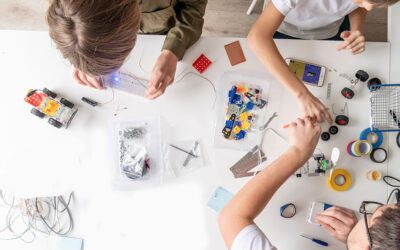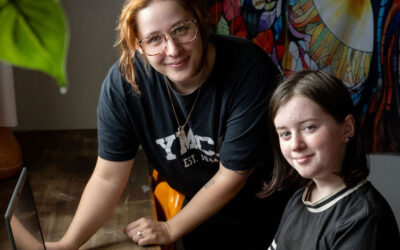“The illiterate of the 21st century will not be those who cannot read and write, but those who cannot learn, unlearn, and relearn.” –Alvin Toffler
Since the phrase ‘The Three Rs’ was first coined way back in 1825, reading, writing and arithmetic have become the cornerstone of education. School days were spent sitting in rows learning by repetition and asking impromptu questions was generally discouraged. However, as we rapidly advance into the digital era, is this 20th century educational mindset still relevant, and does it suitably prepare our children for success in the modern world?
In 2002, the Partnership for 21st Century Skills began looking at the skills students need to be successful citizens beyond school. They identified a set of four essential skills they call the ‘Four Cs’: critical thinking, creativity, collaboration and communication. Since then, schools across Australia have been shifting their pedagogy to address this new skillset, designing active learning environments where students are encouraged to ask questions; where they seek out relevant information and then apply their findings.
Mrs Sue Zweck, Head of Teaching and Learning K-5 at Pacific Lutheran College, explains, “The reality is that today’s wealth of information makes it essential that every student must be able to compare and evaluate facts and opinions and make decisions based on that analysis. We need citizens who know more than ‘about’ something, we need citizens who can take information and apply it to solve problems and create solutions.”

As we move from a manufacturing and industrial economy to a complex future of information and technology, creative thinking skills, adaptability and innovation are now top of the skillset list for many businesses, as they increasingly recognise that these are the skills that will keep companies growing and profitable. The Ernst & Young 2010 Connecting Innovation to Profit report stated: “The ability to manage, organise, cultivate and nurture creative thinking is directly linked to growth and achievement … We assume that 50 per cent of our revenue in five years’ time must come from sources that do not exist today. That is why we innovate.”
The CEDA (Committee for Economic Development in Australia) estimates that, due to technological advancement, more than five million (or 40 per cent) of Australian jobs have a moderate to high likelihood of disappearing in the next 10–15 years. This means that one in three pre-schoolers today will grow up to pursue careers that don’t yet exist, many of these probably being contract or shifting roles as opposed to steady, full-time positions. To support them in this, we need them to be able to flourish in a culture of innovation, self-reliance and change.
Why is creativity critical to the modern classroom?
- Creative thinking encourages children to explore, enquire and discover, which are all crucial for innovation.
- Because children are more engaged and interested, creative learning gives them a deeper understanding of what is being taught and they retain more of their learning.
- Creative thinking encourages children to feel safe in taking risks in their enquiries.
- Without feeling there is right and wrong, children have the opportunity to question and grow.
- Creative thinking encourages thinking outside the box and develops problem-solving skills.
Critical thinking
Leading to better concentration, deeper analytical abilities and improved thought processing, critical thinking has always been a much-respected skill in high-achieving roles. But in an information-driven world where you must sift through the vast array of information to make decisions and find solutions, it has now become a vital skill for everyone – whether choosing household insurance or solving climate change. As well, the jobs least likely to be outsourced or automated are those roles that require critical thinking, complex communication and expert thinking.
To introduce critical thinking into their classrooms, Sue Zweck explains that Pacific Lutheran use the Teaching for Understanding and Visible Thinking from Harvard. “These frameworks guide us to plan instruction that promote higher-order thinking – requiring them to think, internalise and contextualise. Our classroom cultures value questions more than answers and students are equipped with skills for categorising, deconstructing big ideas into component parts and building relationships.”
Creativity
If we look at the big picture, creativity is at the root of progression. Without it there would be no books, no cars,
no medical breakthroughs and no space missions. Creativity calls for curiosity, abstract thought, innovation and empathy.
It requires perseverance and teamwork as well as spontaneity and self-expression. These are all skills that are now critical in today’s world of mass communication and information overload. As Sir Kenneth Robinson, international advisor on education and the arts said, “Creativity is as important in education as literacy and we should treat it with the same status.”
To promote creativity in students, Pacific Lutheran provide a learning culture that values and promotes creative behaviours. “One of the biggest predictors of a person’s creative capacity is their openness to experience. We ensure classroom cultures value risk-taking and that difference can help students overcome their reluctance
to try new things, especially those things at which they might not initially excel. We make it clear that creativity
is a positive, valued attribute of every student.”
Collaboration
Due to globalisation and the rise of technology, collaboration has become critical to 21st century success. Where traditional roles saw individuals working alone, much of today’s significant work is achieved through teamwork, in many cases global teams, where we ‘use the wisdom of crowds’. As author James Surowiecki stated, “A large group of diverse individuals will come up with better and more robust forecasts and make more intelligent decisions than even the most skilled ‘decision maker.’”
Learning to build on one another’s knowledge and expertise involves respect, listening, and contributing. At Pacific Lutheran, they scaffold the learning process by assigning roles, allowing students to see the different tasks needed to complete a project and understand how their strengths can contribute to the overall success of their group. Sue Zweck explains, “We also make sure students have time and opportunities to reflect on their own strengths and weakness, as well as how to utilise the strengths of their team members for maximum effect.”

Communication
Effective communication skills have always been highly valued. However, with the changing nature of literacy, being able to share thoughts, questions, ideas, and solutions in ways others can understand is now essential to 21st century life.
In a world where customer relationships are critical and immediate, communication is far more complex, requiring negotiation across many platforms. Employees need to be able to understand, listen, empathise and communicate in different languages and across several continents. Students must be capable of clear, concise writing as well as effectively using new modes of communication such as video and multimedia tools.
Giving students audiences for their work that value the content and delivery for more than academic purposes is one way of addressing this. “Technology makes it easy to connect students to the world around them, providing an authentic audience for their communication, explains Sue Zweck. “The Web makes it easy to connect to a specific audience, allowing students to share an idea or solution that make a real difference in the lives of real people.”
Acquiring these skills isn’t something that waits until formal education begins. Kath Reilly, Artist in Residence at Banks Street Kindy believes that children need time to practise and develop these skills, and providing opportunities for children to explore play ideas with loose materials is a key part in this process. “We encourage the children to think that they are not able to do something ‘yet’ and to keep practising. It’s okay to make mistakes – what can the child learn from these mistakes.”
Through their Artist in Residence Program, Kath works with the children either in small groups or individually responding to and guiding the children in developing their knowledge and skills. “All their life skills and dispositions are being developed and practised, as they engage in activities that encourage creative thinking – pre-literacy and pre-numeracy skills, fine and gross motor skills, self-regulation, higher-order thinking, language and communication skills and socio-emotional skills as they share ideas and resources,” Kath explains. “From this, children are developing personal and learning dispositions that assist their learning journey; especially the resilience to persevere with ideas.”
Encouraging the 4 Cs at home*
- Use resources that support investigations, critical thinking and reflections. Use information books and IT.
- Accept the mess that goes with creative interactions and pursuits!
- Make the time to have conversations about the how, when and why, depending on the child’s interests and responses.
- Visit nature, the museum, art galleries and other events for as long as the child is interested – it should be fun, because learning is fun!
*Courtesy of Kath Reilly (EN, BFA) Artist in Residence at Banks Street Kindy and Ann Lock (B.Ed Dip BKTC), Director and Educational Leader of Banks Street.
Pacific Lutheran is a leading Kindergarten to Year 12 learning community on the Sunshine Coast that provides a rich education for a well-rounded life. To find out more about the college and their programs, head to pacificlutheran.qld.edu.au or contact (07) 5436 7300.
Banks Street Kindy is a nurturing early childhood setting that extends children’s literacy, numeracy, communication and socio-emotional skills through art, dance and dramatic play. Find out more about their programs at www.banksstkindy.org or contact (07) 3352 6940.


